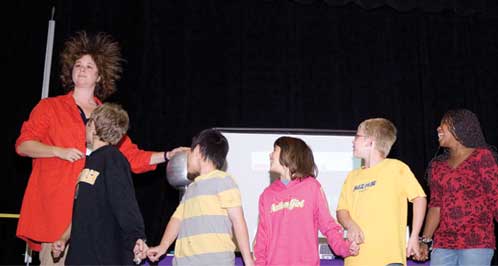 Winter 2008
Winter 2008|
|
A Wild Weather Adventure
 Mindy Gawlas and the Chain of Pain in action.Carnegie Science Center’s Science on the Road educators pull out all the stops—including some hair-raising lessons about weather—to make science fun.
Ooooh, a demonstration!” says Mindy Gawlas, raising her eyebrows for effect. “This one is my favorite—the Chain of Pain.” Some 200 or so students, sprawled out along the floor of the Fred L. Aiken Elementary School gymnasium in Greentree, let out a collective gasp. Ranging in age from kindergarten to fifth grade, they’re engrossed in Wild Weather Adventure, a surprise-around-every-corner game designed and directed by Gawlas, a staff educator at Carnegie Science Center. Minutes earlier, Gawlas had divided the gym into two teams—the Hurricanes and the Tornados. At stake, a victory lap in a virtual balloon race around the world. With each correct answer, teams advance a space. But when the Hurricanes’ team captain spins the wheel, it lands on “Demonstration,” which is Gawlas’ cue to perform. All eyes fix on her as she first presents some facts about lightning and then approaches a table covered with curious-looking equipment. “I have a lightning machine and it isn’t dangerous,” explains Gawlas, “but it makes the same kind of electricity that lightning makes—static electricity.” Then, she wields a silver wand toward a sputtering Van De Graff generator that produces high voltages of static electricity. As the wand nears the generator, a white electric bolt leaps from it with a crack. “Ooooh,” the audience coos. “Now I want to show you how lightning travels,” Gawlas continues. “I need several victims, um, I mean volunteers.” Despite the hint of harm, nearly every hand shoots into the air. Gawlas selects six students and directs them to stand in a line and link pinky fingers. Gawlas stands on an orange milk crate so she isn’t grounded, and rolls up the sleeves of her red jacket. “When I am all charged up, I think you’ll be able to tell,” she muses. And as she rests her hand on the generator, her medium-length brown hair stands on end. Laughter erupts. She and Danny, the first boy in the line, touch elbows. A spark flies from her elbow to Danny’s. He jerks his arm away and soon every child in the line pulls away from the surprise of the shock. “I saw the lightning coming out of my elbow and it traveled through our bodies,” Gawlas explains. “Who knows what the pathway is in the body that allows the lightning to travel?” “Water!” shout the students. It’s a typical weekday for Gawlas, who as an educator in the Science Center’s Science on the Road program, performs a science show in a different area elementary and middle school nearly every day in the fall. The Science Center reaches more than 170,000 children a year through the work of its outreach program. Today the show is all about weather. Yesterday it was about conserving the environment. Tomorrow the topic could focus on chemistry or the life sciences. Teachers at each school get to request the program they think will best supplement their own classroom learning. “We try to provide a big wow factor in every show,” Gawlas explains. “We also try to show something that is too expensive for schools to buy themselves, and offer a different method for providing key information.” The idea is to entertain and educate simultaneously by presenting information in a game-show format, as a mystery, or even as a version of musical chairs. The method works, as is obvious at Aiken Elementary: The kids can barely stay in their seats. They pump fists into the air, high-five one another, and cheer as if this were the Super Bowl, not a game about the science behind weather. And much like science, putting on a great assembly requires trial and error. After the Chain of Pain, Gawlas unveils the tornado cannon, a long metal tube that looks a lot like a flagpole. “This will show the power of a mid-range tornado,” she tells her captive audience. “A tornado can happen anywhere, at any time of day, but they are more likely to occur in Tornado Alley.” Gawlas lays the cannon on the table and holds up a pencil before placing it in the tube. At the base of the pole, she slides a piece of wood about an inch-thick into a slot with a piece of metal resting behind it. She warns the students to cover their ears. She hooks a hose to the top of the tube. Seconds later, the pencil shoots through the tube at 150 miles per hour and a loud t-h-w-a-c-k echoes through the gym. Gawlas strides over to the base of the cannon and picks up the wood. The pencil broke it in half. What the students don’t know is that it took Gawlas and the team at the Science Center’s fabrication shop many tries before the cannon was safe for schools. At first, the pencils flew erratically and the wood splintered, making dangerous projectiles. But that, too, is all part of the fun, says Gawlas. The fun of science. “It’s really hard to find a kid who doesn’t like science,” she says. “We try to bring science to an informal level for the kids, so they see that science is fun and that science is around us in the world every single day. These types of experiences engage and inspire young people. And who knows? Some of those kids in the audience may one day aspire to become scientists themselves.” |
Darwin’s Big Bang: 150 Years Later · Paging Doctor Darwin · The Horse · 1958 · Director's Note · NewsWorthy · Now Showing · Face Time: Eric C. Shiner · Artistic License: Inside a Fantastical Mind · Science & Nature: All Hail the Telescope · First Person: Experiencing Life on Mars, Together · Another Look: Andy Warhol's Time Capsules
 |
Copyright © 2017 CARNEGIE Magazine. All rights reserved. |
